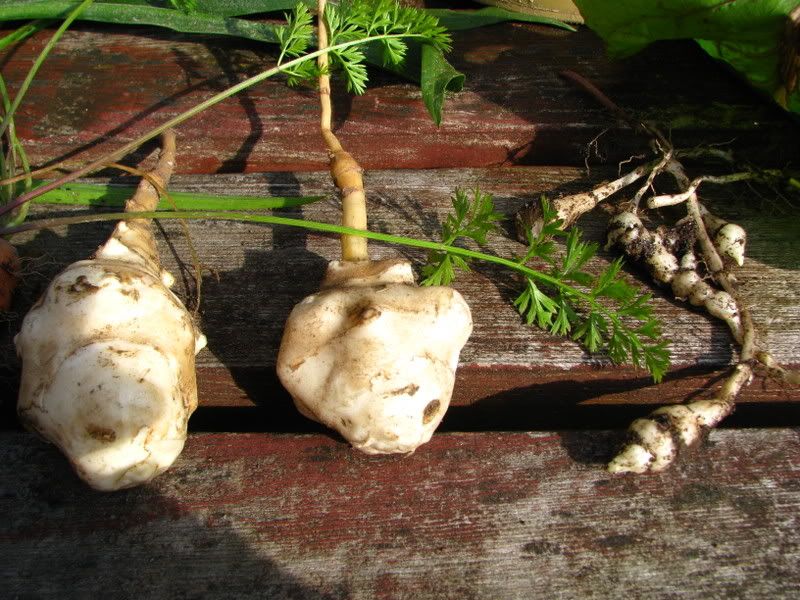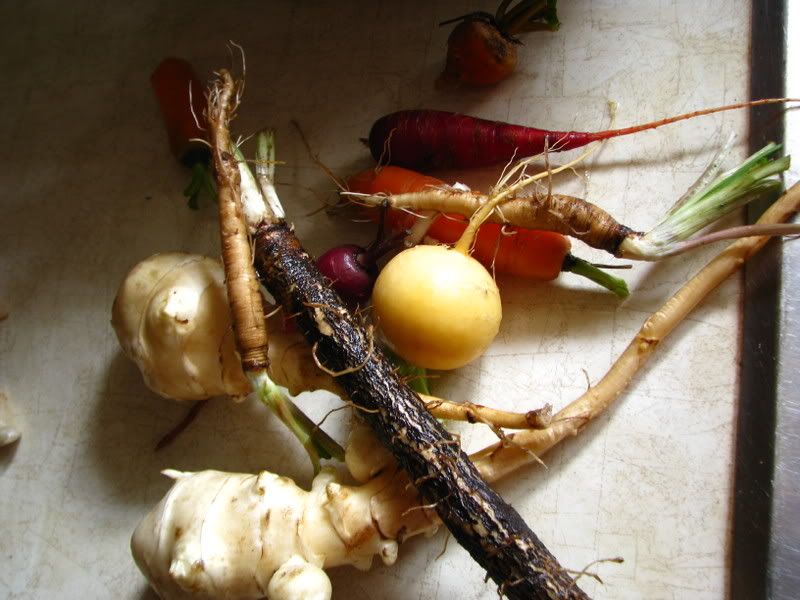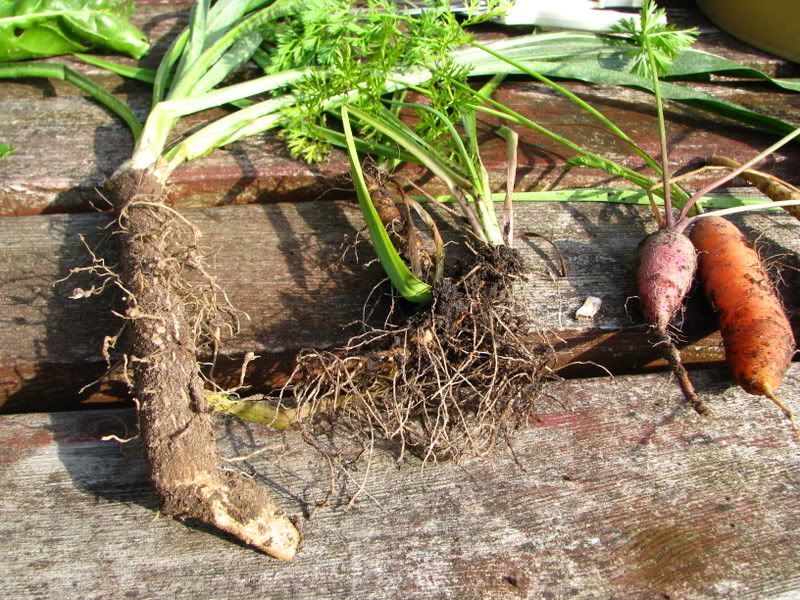Carrots, turnip, beets, scorzonera (black skin), jeruselum artichoke (bumpy thing), and salsify (thin white roots)
Freshly pulled are dandelion, chicory, beets, carrots, jeruselum artichoke, chinese artichoke, salsify, scorzonera, horseradish, sweet cicely, and turnip. Next year, I hope to add skirret (tried to grow these before but no luck), apios (already added thanks to a generous gardening friend), tuberous sweet pea (found a patch in Gatineau park), turnip rooted chevril, hamburg rooted parsley and more parsnip. I might even grow rampions (campanula rampunculus) but then again, I think it already grows in my yard as a weed.
From left to right: chicory, horseradish and sweet cicely (the last two look similar but feel and taste very different).
You may wonder why I have such a thing for roots but in the cold climate of Ottawa, a root cellar can mean the difference between eating store bought food and cooking from the fresh larder of your own garden. I am lucky enough to have an old cellar built under our front step which is the right temperature but a little dry for root storage. To compensate, I put bowls of water down there and sprinkle a little on top of my roots from time to time.Scorzonera, salsify (both collectively known as oyster root) and carrot
Also, some roots are great for forcing in the winter to produce fresh greens. Of the above, you can eat the leaves of dandelion, chicory, beet, carrot, scorzonera, horseradish (young leafs), turnip, and sweet cicely. Of course, you can also eat parsley but not the leaves of the turnip rooted chevril. Particular types of chicory are grown for the purpose of forcing them in darkness to produce tasty crunchy chicons for the gourmet market. Thankfully the plant itself is easy to grow in the home garden as are many roots.
Left to right: Jeruselum Artichokes and Chinese Artichokes
Given a light soil (though there are varities of many of these vegetables that will grow in heavy soil such as oxheart carrot, egyptian beet and Russian Kral parsnip), roots require little space compared to other vegetables and some will even take a little shade. They are also the basis for many a meal from mashed to baked to fried to boiled. The famous 'root' used for these purposes is the potato which is actual a tuber but I am playing fast and loose with the definition here. Any undergrown food storage organ is being named 'root' in this post.
In Ottawa you can also grow Gobo (or wild burdock as I'm sure you know if you've ever taken a dog on a country walk), wild carrot / Queen Anne's Lace, short season sweet potato (I did last year with great success), tiger lily (really?), evening primrose, daylily (really, really?),jicama(according to Solana Seeds - who knew), chufa (have grown but was difficult to process) , dog's tooth violet (according to one source only survival food but it's pretty and native here), and many aquatic species such as the very useful cattail, and I'm sure I'm missing something.
-- inserted next day: how about radishes and rutabagas? (someone else should really be at the helm of this brain ship) --
I have the last two in my garden but extraction of a couple first year primerose rosettes revealed no tap root so I shrugged and moved on. The daylily I haven't tried yet.
* You can also cheat by digging a trench and filling it with loose soil or using a crowbar, shoving it into the ground, whirling it around to make a cone and filling with loose soil then planting your seed at the top.
***
Root storage and inulin
And now a fun little lesson. Inulin is a polysaccarhide that is used by many plants to store food. It can give people gas and if I remember correctly, it is one of the culprits in beans. In one of my wild edible food books, the writer talks about cooking roots with high amounts of inulin to break it down. Unlike many people who complain after they eat Jeruselum Artichoke of a gassy tummy, I don't normally react like that. I don't know if this is because of the variety I grow, the way I cook it or my own digestive system but I thought this was an interesting factiod.
More on inulin at Doc Weed's Doin's
Links:
Four Season Harvest by Coleman
Plants for a Future - has other roots that grow in milder climes as well
Wikipedia entry on edible roots with specific classifications between taproots, tuberous roots, modified stems and so on.




5 comments:
Hello, thanks for visiting my blog and leaving your funny and kind comments. There's so much to read on yours, and you're so knowledgeable! Goodness, I have so much to learn!
Wow that is quite a root harvest! You have inspired me to do more with roots. I'm sure I can find some dandelions out there. I'm waiting for after the first frost to dig up my jerusalem artichokes because I read somewhere that they are sweeter after a frost.
Coriander: I read the same thing and conviniently my JAs aren't really read until near first frost.
Reading about these unusual roots really makes me want to taste them, but maybe slim chance in Houston Texas. This as an inspiring post and I will be thinking about root crops as I build my new vegetable garden. Enjoyed finding your blog!
Love the inulin info - thanks for the link to Doc Weed.
I've had lathyrus tuberosus, aka Dutch Mice, for quite a few years now, so I can testify to its hardiness (zone 3-4). It's a lovely plant, the flowers are beautiful, but the tubers a few and far between, at least here.
CORIANDER - you can also harvest Jerusalem artichokes before they blossom, when the small roots are mild and crisp.
Post a Comment